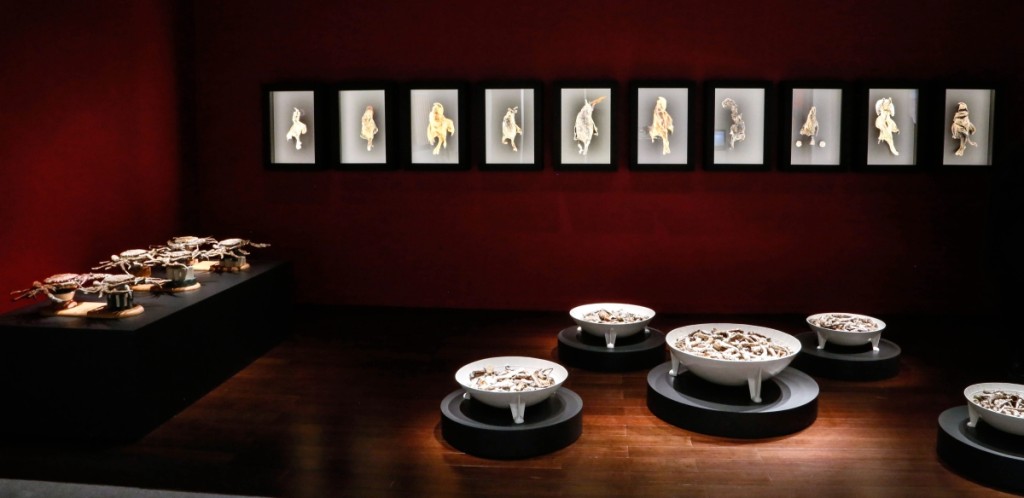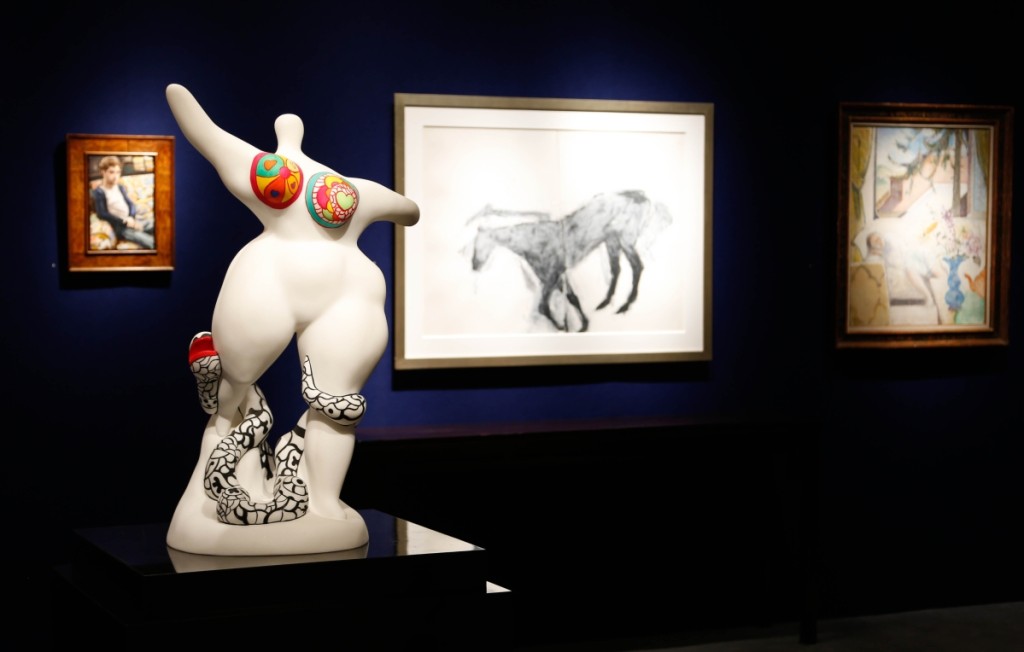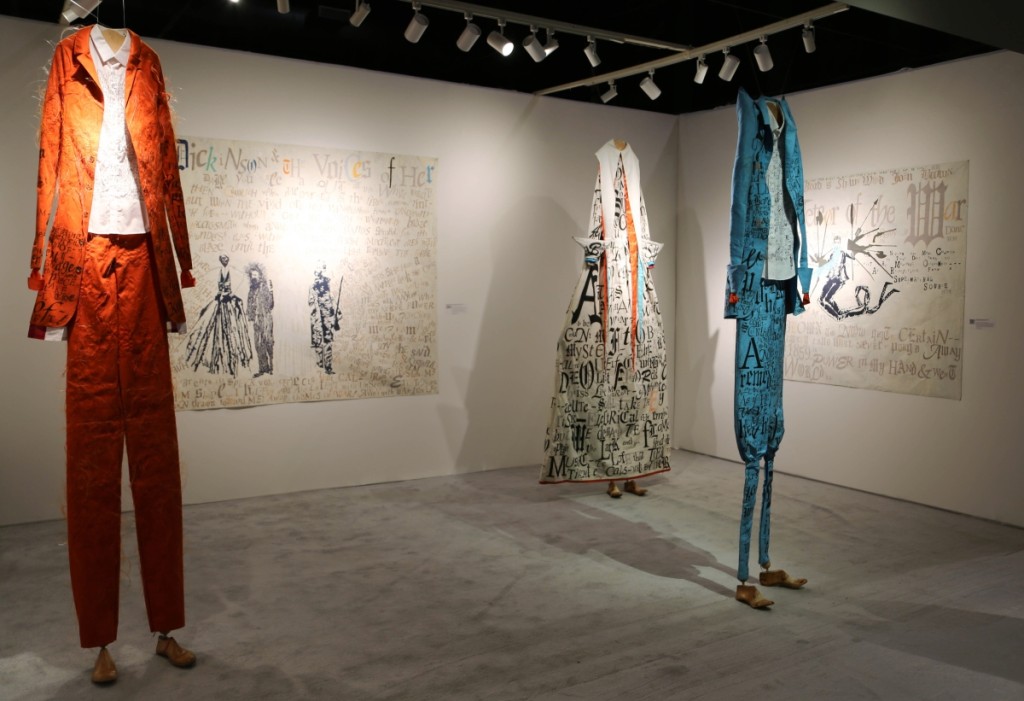Review and Photos by Greg Smith
NEW YORK CITY – The Art Show, mounted by 72 member galleries of the Art Dealers Association of America (ADAA), presented its annual edition at the Park Avenue Armory February 28 through March 3. When looked over as a whole, the show represents an intimate consortium of exhibitions from domestic and international dealers, many of them featuring modern art, others featuring contemporary and a notable few exhibiting historic works, the dateline beginning at the Nineteenth Century and continuing through today. The dynamic range presented by some of the world’s leading curators was captured by single-artist exhibitions, dealer collaborations and thematic exhibitions of artists across time periods.
For 31 years, the ADAA has supported the Henry Street Settlement, which delivers a wide range of social service, arts, and healthcare programs to more than 50,000 New Yorkers each year. This year’s edition raised $1.2 million for the organization, bringing the total amount raised for the nonprofit to $32 million over the course of their partnership.
“It’s immensely rewarding to see our supporters and friends enjoying a constellation of the world’s greatest art and knowing that their presence is sending a student to college, housing a homeless family or ending an older adult’s isolation,” said David Garza, executive director of the Henry Street Settlement. “As our single largest source of flexible funding, The Art Show significantly furthers our 125-year commitment to identifying the most challenging social conditions and responding through programs.
Andrew Schoelkopf, ADAA president and co-founder of Menconi + Schoelkopf, iterated on this edition’s strengths, saying “I am particularly proud of the overall appearance, energy and curatorial approach our colleagues brought to the fair this year. It was the most energetic and successful fair in recent memory, and we were thrilled with the traffic, experience and the very significant funds raised for our partner, the Henry Street Settlement.
On the exhibition end, Menconi + Schoelkopf presented a curated selection of masterworks of the Twentieth Century, including paintings by Georgia O’Keeffe, Milton Avery, Marsden Hartley, Thomas Hart Benton and Max Weber accompanied by sculpture from Elie Nadelman and John Storrs. While Avery’s two works in the show, “Woman at the Telephone” and “Morning Talk” were created 20 years apart, 1943 and 1963 respectively, they both speak to the midcentury woman’s domestic life in much the same way. Hartley’s electric 1910 landscape “Birch Grove, Autumn” is a deaccession from the Museum of Modern Art, to benefit the acquisition fund. Thomas Hart Benton’s 1932 oil and paper collage on artist’s board “We, The People” was the cover art for the book of the same name by Leo Huberman. The work had descended in the Huberman family until 2009, when it entered a private collection and now comes to sale for the second time.
Per his exhibition, Schoelkopf said, “Interest in those works was strong across the board – particularly with regard to the two important figure paintings by Milton Avery. Avery works of large scale and high quality are enormously popular, in large part because they appeal to modernist collectors and to collectors of postwar and contemporary art.”
New York City dealer Jill Newhouse reported to Antiques and The Arts Weekly that she had a successful show, selling from her exhibition of artworks centered around the Nineteenth Century French Romantic artist Eugène Delacroix. Newhouse’s exhibition also included contemporary print works by Peter Doig, Cecily Brown and Elizabeth Peyton, all of whom directly referenced Delacroix in their works, and all sold. Of the Delacroix works, Newhouse confirmed that three had found new homes, including a watercolor on paper titled “Seated Lion in a Landscape,” an 1817 pencil on paper study titled “Academic Male Nude” and an 1830s pencil on paper featuring a torso of a man seen from behind, which was a study for the mural at The Salon du Roi, Palais Bourbon, Paris.
New York City and Guilford, Conn., dealer Thomas Colville delivered an exhibition on American Abstraction from the 1930s and 40s. The exhibition included the Park Avenue Cubists, including Charles Green Shaw, Albert Eugene Gallatin and George L.K. Morris, along with Werner Drewes, in contrast with their American counterparts in the West working in the same period, including Raymond Jonson. The starkly different landscapes surrounding these artists would form the basis of their subjects. A Drewes painting that depicts a cubist interpretation of a quintessential Eastern seaboard painting – a lighthouse at the edge of a rocky shoreline – contrasts with Jonson’s “Watercolor No. 7,” a cool-tempered classic Western landscape with a rock formation at its center and distinct parallel rays of light beaming down through the clouds in select areas. Colville sold six works during the show run, including “Indian Emblems,” an oil by George L.K. Morris; an oil titled “Abstract Composition” by Albert Gallatin; two abstract oils by Charles Green Shaw; and a casein by Raymond Jonson.
Born the son of an African Methodist Episcopal bishop, Henry Ossawa Tanner had a relationship with God that would inspire some of the most profound religious artworks of the late Nineteenth and early Twentieth Centuries. Tanner’s exhibition at New York City’s Michael Rosenfeld Gallery focused on works from 1893 to 1924, the center wall of the gallery’s booth highlighted by three of the artist’s paintings featuring his unmistakable illumined blue tones. Flanked by two Tangier street scenes, the centerpiece of the exhibition was a circa 1920-24 oil on canvas work titled “Sodom and Gomorrah.” Other religious-themed paintings included “Mary Washing The Feet Of Christ,” “Two Disciples At The Tomb,” and “Hills of Jerusalem.” The latter work would be sold during the fair’s run as well as the earliest Tanner work in the exhibition, “Edge of The Forest (Bois d’Amour).”
On the quality of the fair, Michael Rosenfeld Gallery’s director Halley K. Harrisburg said, “The ADAA fair represents an organization of highly respected and honorable dealers that have been vetted and lauded for their excellence. We respect each other, inform each other and collectively represent a standard of excellence for the industry. It is always an honor to exhibit and be a representative of the profession.”

An exhibition of two series of works, “Ether en Flocons” and “Putiferio,” by Italian artist Roberto Cuoghi was on show at Hauser & Wirth.
Jonathan Boos, a relatively new member to the ADAA, presented an exhibition on surface in the New York City gallery’s sophomore year at the show. The exhibition included Sam Gilliam, George Copeland Ault, Helen Lundeberg, Charles Sheeler and Stuart Davis. On Gilliam’s nine-sided 1980 “King of Prussia” acrylic on canvas work, Boos said, “Gilliam just loves to create great colorful surfaces with thick paint. You can see the rakes he would use to drag through the work and create the most incredible surface.”
Collaborative exhibitions included a showing of works from Judy Chicago mounted by Jessica Silverman Gallery and Salon 94. Chicago’s work was bolstered by the minimalist color-wheel “Dome Paintings” and “Donut Drawings,” as well as by ceramic sculptures that included “Bigamy” from 1964, and “Two-Faced Toby Mugs,” executed in 2010. Another collaborative exhibition was found between Frankel Gallery and David Zwirner, who presented a show of works from two of the top portraitists of the Twentieth Century: Diane Arbus and Alice Neel.
Works from contemporary American artist Sam Moyer were found with Sean Kelly Gallery, New York City. The compositions included previously used flat stone fields surrounded by a tailor-fit painted surface. The materials of the stones vary, including marble, caesarstone, slate, travertine and terrazzo concrete. The gallery said, “Sam’s work is very unique in that it reinvents the modernism conversation, pushing the language of abstraction and the roles of sculpture and painting.” The gallery reported that they sold all eight of Moyer’s works at the fair.
International dealership Hauser & Wirth presented a dramatically-designed exhibition with works from Italian artist Roberto Cuoghi from his 2016 “Putiferio” series and his 2016-18 “Ether en Flocons” series. Cuoghi’s “Putiferio” series focused on highly detailed crabs and dismembered crabs legs in large bowls. The works were scanned from actual crabs, printed in clay and then fired in a self-made kiln, with the artist left to embellish the details. “Putiferio” means “to bring out the odors of hell” in Latin, reminiscent of the smell emanating from the fish markets after a hot day. Cuoghi’s “Ether en Flocons” series featured an installation of ten birds made from agar-agar and pork gelatin suspended in individual cases. The birds appeared as if they were dried, featherless corpses: a month-long freeze dry was among the artist’s techniques for this series.
Schoelkopf concluded, “The fair seemed different and more thoughtful to me this year. Part of that was due to the strong applicants we had for this year’s program, and my colleagues in the ADAA certainly brought their strongest material… You have blue-chip masterworks and the work of emerging artists presented in a thoughtful and curated manner, and that means that those who attend the Art Show each year are engaged in a very special and different experience.”
The show plans to be back at the Park Avenue Armory in 2020. For more information on The Art Show, www.artdealers.org/the-art-show/information or 212-488 5550. For more information on the Henry Street Settlement, www.henrystreet.org.






























